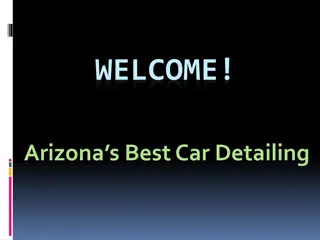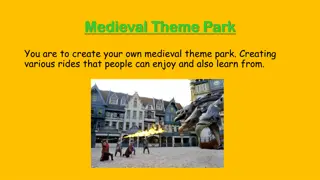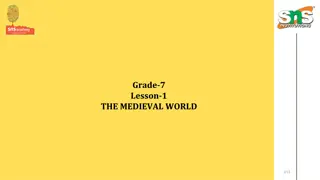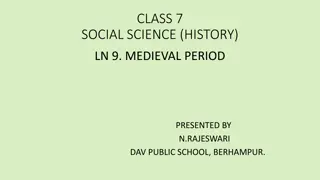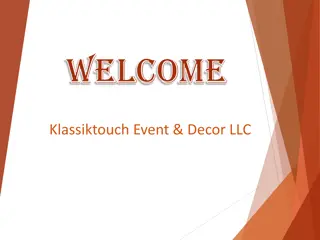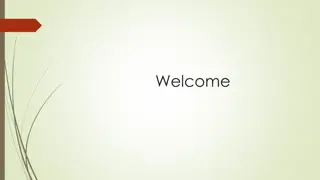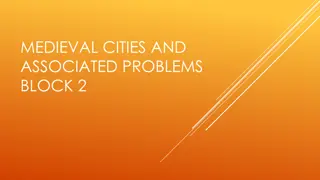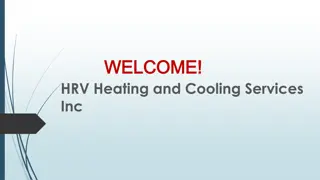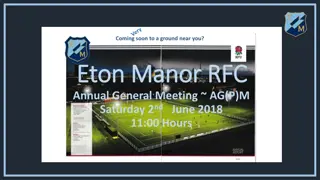Life on a Medieval Manor: A Glimpse into Manor Living in Medieval Times
Discover the intriguing lifestyle on a medieval manor, where peasants to nobles played vital roles. From daily activities to the hierarchy within, explore the dynamics of living and working on a medieval estate.
Download Presentation

Please find below an Image/Link to download the presentation.
The content on the website is provided AS IS for your information and personal use only. It may not be sold, licensed, or shared on other websites without obtaining consent from the author. Download presentation by click this link. If you encounter any issues during the download, it is possible that the publisher has removed the file from their server.
E N D
Presentation Transcript
THE MANOR Villages on a Manor usually had less than 600 residents. They produced everything they needed: Food, Clothing, and Farming Tools. Peasants lived in wattle and doub homes, or a not-so-well put together cottage. The Manor House was were the lord and his family lived. A fun fact is that the kitchen was outside of the main building in case of a fire.
The Manor contained Peasants, Knights, Lords, and Nobles. There were usually large fields around the Manor used for livestock, crops, and hunting. The only people allowed to hunt in the manor s forests were nobles. There was usually a church and a village that had blacksmiths, bakers, and peasants. THE MANOR CONT. THE MANOR CONT.
PEASANTS LIVES Worked from sunrise to sundown growing food and making other products for their families, lords, or to sell to towns. Peasants were usually serfs and were not allowed to leave the manor without the lords permission. Serfs were given land and a house in order to do wok for the lord. Free peasants rented land from the lord and didn t have to work for him.
LIFE AS A PERSON ON A MANOR People living on a manor were either peasants, trades people, women/children, or a higher class official Peasants would farm and grow food for the manor to make money. Trades people would be millers, bakers, smiths, or carpenters to sell and trade their products Women and Children would make clothes and meals or tend gardens and look after livestock
THE LORD Lords were usually previous knights who mostly had more than one manor to look over. Their wealth came from the food, rents, fines, and fees they collected from the peasants. If a lord wasn t looking after his land, the overlord would reassign a lord to look after the manor. The lord and his family usually lived in large stone houses called the manor house. It had several rooms that were kept clean and nice at all times
RUNNING THE MANOR The lords with large manors usually had several hired people to help them. The most important assistants were the steward, the bailiff, and the reeve. The steward supervised all of the manors the lord had. The bailiff was the lord s representative on the manor and would instruct duties for the peasants. The reeve was a wealthy peasant instructed to help the bailiff.
THE CHURCH Christianity was common in European manors. The church was usually the largest building in the manor. People went every Sunday to pray and mark important times in their lives. The church was also used as a meeting place for community events.
CELEBRATIONS Peasants would rest from hard days work by joyfully celebrating festivals. They would celebrate Christmas, Easter, Saints Days, and the Seasons. Saints day was a day to honor their overseer called a saint.
DIFFICULT TIMES IN A MANOR Famine, Diseases, and Peasant Famine, Diseases, and Peasant Rebellions were forms of hard Rebellions were forms of hard times in Medieval life. times in Medieval life. Peasants would produce Peasants would produce enough for their lords but enough for their lords but sometimes not enough for sometimes not enough for everyone. If crops were everyone. If crops were damaged famine would be a damaged famine would be a result. result. Diseases such as the Plague, or Diseases such as the Plague, or the Black Death, traveled on the Black Death, traveled on ship by rats. There was both the ship by rats. There was both the bubonic and pneumonic plague bubonic and pneumonic plague Peasant Rebellions were Peasant Rebellions were common when there conditions common when there conditions of working got worse. of working got worse.
THE END THE END





